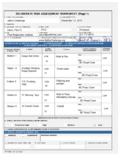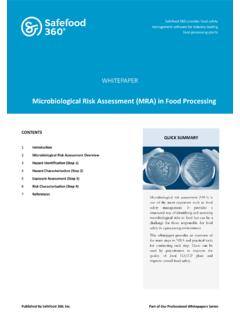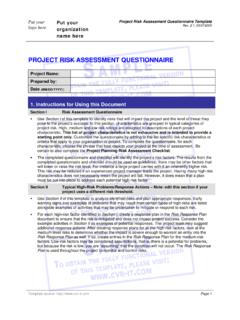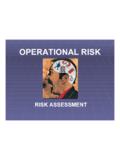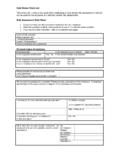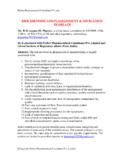Transcription of Risk assessment: A brief guide to controlling risks in …
1 Health and Safety ExecutivePage 1 of 5 This leaflet is aimed at employers, managers and others with responsibility for health and safety. It will also be useful to employees and safety part of managing the health and safety of your business, you must control the risks in your workplace. To do this you need to think about what might cause harm to people and decide whether you are taking reasonable steps to prevent that is known as risk assessment and it is something you are required by law to carry out. If you have fewer than five employees you don t have to write anything risk assessment is not about creating huge amounts of paperwork, but rather about identifying sensible measures to control the risks in your workplace. You are probably already taking steps to protect your employees, but your risk assessment will help you decide whether you have covered all you need about how accidents and ill health could happen and concentrate on real risks those that are most likely and which will cause the most harm.
2 For some risks , other regulations require particular control measures. Your assessment can help you identify where you need to look at certain risks and these particular control measures in more detail. These control measures do not have to be assessed separately but can be considered as part of, or an extension of, your overall risk assessment . Identify the hazardsOne of the most important aspects of your risk assessment is accurately identifying the potential hazards in your good starting point is to walk around your workplace and think about any hazards. In other words, what is it about the activities, processes or substances used that could injure your employees or harm their health?When you work in a place every day it is easy to overlook some hazards, so here are some tips to help you identify the ones that matter: Check manufacturers instructions or data sheets for chemicals and equipment as they can be very helpful in explaining the hazards and putting them in their true perspective.
3 Risk assessmentA brief guide to controlling risks in the workplaceThis is a web-friendly version of leaflet INDG163(rev4), published 08/14 Health and Safety ExecutiveRisk assessment : A brief guide to controlling risks in the workplace Page 2 of 5 Look back at your accident and ill-health records these often help to identify the less obvious hazards. Take account of non-routine operations (eg maintenance, cleaning operations or changes in production cycles). Remember to think about long-term hazards to health (eg high levels of noise or exposure to harmful substances). Visit the HSE website ( ) HSE publishes practical guidance on hazards and how to control are some hazards with a recognised risk of harm, for example working at height, working with chemicals, machinery, and asbestos. Depending on the type of work you do, there may be other risks that are relevant to your might be harmed?
4 Then think how employees (or others who may be present, such as contractors or visitors) might be harmed. Ask your employees what they think the hazards are, as they may notice things that are not obvious to you and may have some good ideas on how to control the risks . For each hazard you need to be clear about who might be harmed it will help you identify the best way of controlling the risk. That doesn t mean listing everyone by name, but rather identifying groups of people (eg people working in the storeroom or passers-by). Remember: Some workers may have particular requirements, eg new and young workers, migrant workers, new or expectant mothers, people with disabilities, temporary workers, contractors, homeworkers and lone workers ( ). Think about people who might not be in the workplace all the time, such as visitors, contractors and maintenance workers.
5 Take members of the public into account if they could be harmed by your work activities. If you share a workplace with another business, consider how your work affects others and how their work affects you and your workers. Talk to each other and make sure controls are in place. Ask your workers if there is anyone you may have missed. Evaluate the risksHaving identified the hazards, you then have to decide how likely it is that harm will occur, ie the level of risk and what to do about it. Risk is a part of everyday life and you are not expected to eliminate all risks . What you must do is make sure you know about the main risks and the things you need to do to manage them responsibly. Generally, you need to do everything reasonably practicable to protect people from harm. This means balancing the level of risk against the measures needed to control the real risk in terms of money, time or trouble.
6 However, you do not need to take action if it would be grossly disproportionate to the level of risk assessment should only include what you could reasonably be expected to know you are not expected to anticipate unforeseeable risks . Health and Safety ExecutiveRisk assessment : A brief guide to controlling risks in the workplace Page 3 of 5 Look at what you re already doing and the control measures you already have in place. Ask yourself: Can I get rid of the hazard altogether? If not, how can I control the risks so that harm is unlikely? Some practical steps you could take include: trying a less risky option; preventing access to the hazards; organising your work to reduce exposure to the hazard; issuing protective equipment; providing welfare facilities such as first aid and washing facilities; involving and consulting with health and safety need not cost a lot.
7 For instance, placing a mirror on a blind corner to help prevent vehicle accidents is a low-cost precaution, considering the risks . Failure to take simple precautions can cost you a lot more if an accident does your workers, so you can be sure that what you propose to do will work in practice and won t introduce any new hazards ( ).If you control a number of similar workplaces containing similar activities, you can produce a model risk assessment reflecting the common hazards and risks associated with these activities. You may also come across model assessments developed by trade associations, employers bodies or other organisations concerned with a particular activity. You may decide to apply these model assessments at each workplace, but you can only do so if you: satisfy yourself that the model assessment is appropriate to your type of work; adapt the model to the detail of your own work situations, including any extension necessary to cover hazards and risks not referred to in the model.
8 Record your significant findingsMake a record of your significant findings the hazards, how people might be harmed by them and what you have in place to control the risks . Any record produced should be simple and focused on controls. If you have fewer than five employees you don t have to write anything down. But it is useful to do this so you can review it at a later date, for example if something changes. If you have five or more employees you are required by law to write it paperwork you produce should help you to communicate and manage the risks in your business. For most people this does not need to be a big exercise just note the main points down about the significant risks and what you easy way to record your findings is to use our risk assessment template ( ).When writing down your results keep it simple, for example fume from welding local exhaust ventilation used and regularly checked.
9 Health and Safety ExecutiveRisk assessment : A brief guide to controlling risks in the workplace Page 4 of 5A risk assessment must be suitable and sufficient, ie it should show that: a proper check was made; you asked who might be affected; you dealt with all the obvious significant hazards, taking into account the number of people who could be involved; the precautions are reasonable, and the remaining risk is low; you involved your employees or their representatives in the process. Where the nature of your work changes fairly frequently or the workplace changes and develops (eg a construction site), or where your workers move from site to site, your risk assessment may have to concentrate more on a broad range of risks that can be a look at the selection of example risk assessments on HSE s website ( ). They show you what a completed risk assessment might look like for your type of workplace.
10 You can use these as a guide when doing your site also has online risk assessment tools, to help employers complete and print off their own records. If your risk assessment identifies a number of hazards, you need to put them in order of importance and address the most serious risks long-term solutions for the risks with the biggest consequences, as well as those risks most likely to cause accidents or ill health. You should also establish whether there are improvements that can be implemented quickly, even temporarily, until more reliable controls can be put in , the greater the hazard the more robust and reliable the measures to control the risk of an injury occurring will need to review your risk assessmentFew workplaces stay the same. Sooner or later, you will bring in new equipment, substances and procedures that could lead to new hazards.











